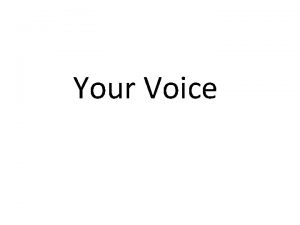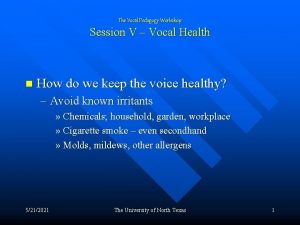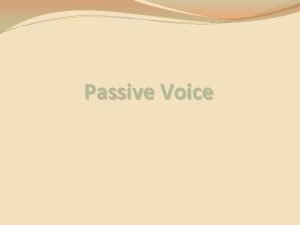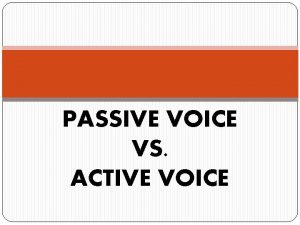Vocal Health Vocal Health The Human Voice Vocal
















- Slides: 16

Vocal Health

Vocal Health The Human Voice Vocal Technique Healthy Singing Vocal Injury and Fatigue Warning Signs

The Human Voice ü Vocal Folds ü Larynx ü Resonators ü Articulators

The Human Voice ü The Voice is a Wind Instrument. ü In most woodwind instruments, the air passes over a reed causing the reed to vibrate thus causing the sound. ü With the voice, the air passes through the vocal folds causing them to vibrate making a sound.

The Human Voice ü The vocal folds are located inside the larynx. ü They are attached to the inside of what is commonly called the Adam’s Apple. ü They are about the diameter of a small paper clip.

The Human Voice ü High pitches: The vocal folds become longer, thinner, and more tense. ü Low Pitches: The vocal folds become shorter, thicker, and less tense. ü This is an involuntary change. ü When at rest, the vocal cords are apart allowing air to freely pass without making sound.

The Human Voice -Resonators: ü Mouth ü Sinuses ü Larynx ü Oral and Nasal Passages No two people have the same size resonators so no two voices sound alike.

The Human Voice -Articulators: ü Lips ü Teeth ü Tongue ü Palate

Technique ü Posture ü Breath support ü Tension ü Healthy Tone

Healthy Singing ü Use good tone ü Use proper posture. ü Use proper breath support. ü Sing within your range. ü Avoid jaw or neck tension. ü Avoid singing with manufactured vibrato.

Healthy Singing: Tips for Healthy Voices ü Drink seven to ten 8 -ounce glasses of WATER per day. (No Caffeine or Alcohol) ü Always warm up before you sing. ü Balance voice use time with vocal rest time. ü Do not sing with a sore throat.

Healthy Voices ü Do NOT Smoke! ü Do NOT Drink Alcohol. ü Do NOT use drugs.

Vocal Injury and Fatigue ü Screaming, over-singing, singing on a sore throat, cold weather, excessive talking, talking over road noise can all cause vocal fatigue & injury. ü Avoid coating the throat with sugar or dairy before singing.

Vocal Injury and Fatigue When you are sick: ü Get lots of rest. ü Eat healthy. ü Drink lots of fluids (no caffeine) ü Do not sing with a sore throat. ü Vocal rest (including talking) The voice heals slowly.

Signs of Vocal Abuse ü Pain ü “Frog in the throat. ” ü Loss of voice ü Inability to relax the throat. ü Pitch problems - voice becomes uncontrollable.

Disclaimer: This presentation is intended to make you more knowledgeable about the voice and how to take care of your instrument. ü Do not over react. ü Do not become a hypochondriac. ü Be sensible and smart. ü Do not become a diva and/or wear a scarf indoors to “keep your voice warm. ”
 False and true vocal cords
False and true vocal cords Two vocal styles in singing of pakistan
Two vocal styles in singing of pakistan Active and passive voice pattern
Active and passive voice pattern Passive and active voice chart
Passive and active voice chart Passive voice machine
Passive voice machine Present indefinite tense
Present indefinite tense What is a passive sentence
What is a passive sentence Passive voice cvičenia
Passive voice cvičenia Hát kết hợp bộ gõ cơ thể
Hát kết hợp bộ gõ cơ thể Bổ thể
Bổ thể Tỉ lệ cơ thể trẻ em
Tỉ lệ cơ thể trẻ em Gấu đi như thế nào
Gấu đi như thế nào Tư thế worm breton
Tư thế worm breton Chúa yêu trần thế
Chúa yêu trần thế Môn thể thao bắt đầu bằng từ chạy
Môn thể thao bắt đầu bằng từ chạy Thế nào là hệ số cao nhất
Thế nào là hệ số cao nhất






























